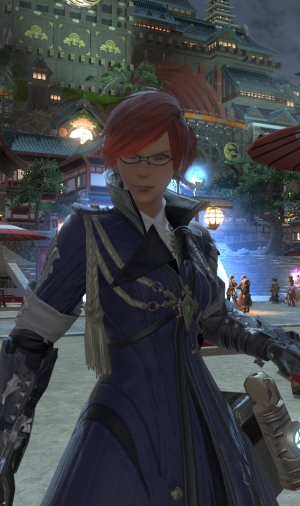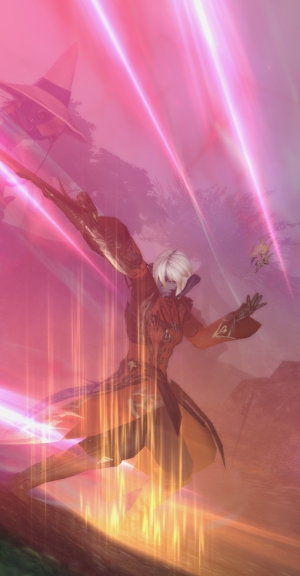
The good news, then, is that it sticks the landing.
Everything that worked well in Heavensward has been brought forward and refined, and the parts that hadn’t worked so well have been trimmed away, repurposed, or outright removed. It feels very much like an expansion to the same core game, but in the process it manages to address almost every complaint I had over Heavensward almost incidentally. And it continues on in the high standards the game has set for itself over the years, resulting in an expansion which I’m already in love with after finishing the main storyline.
 The premise of the story was pretty clearly established at the end of the prior expansion, of course; in the wake of an unexpected attack, the Eorzean Alliance (newly flush with Ishgardian forces) is pushing across the border into the long-occupied land of Ala Mhigo. The goal, then, is to push through Imperial defenses with the help of resistance forces and take out Zenos yae Galvus, regent of the area and Legatus of the XIIth Legion.
The premise of the story was pretty clearly established at the end of the prior expansion, of course; in the wake of an unexpected attack, the Eorzean Alliance (newly flush with Ishgardian forces) is pushing across the border into the long-occupied land of Ala Mhigo. The goal, then, is to push through Imperial defenses with the help of resistance forces and take out Zenos yae Galvus, regent of the area and Legatus of the XIIth Legion.
In the interests of not spoiling anything that isn’t spoiled already in the trailer for the game, I’ll just say it doesn’t work out as planned. And players ultimately find themselves heading to the Far East, first to the port city of Kugane, to liberate Doma from Imperial aggression and weaken the Empire on two fronts.
While I greatly enjoyed Heavensward’s story as a whole, I honestly like Stormblood’s more. Part of the reason for that is that it involves none of the usual magical MacGuffins along the way; the story is told almost entirely around political maneuvering, with only a few magical doodads in the background here and there. But it also flows better, with only one or two diversions that seem to be not strictly necessary.
Sadly, one of those diversions includes a Primal fight. You’ll know it when you get there.
It also winds up being an unexpectedly hopeful expansion. Heavensward was very much about cycles, about locking into patterns and how difficult and impossible it could be to not perpetuate those patterns. Stormblood is about finding hope when it seems dead, and it gives you every reason to despair repeatedly… but then the light comes.
When you look at the situation in the game, it’s bleak. Dig deeper, and it becomes even bleaker. Yet despite everything, the conflicts in question can be dealt with. And eventually, hope shines through despite everything.
The polish on the story this time is improved as well; characters move about more naturally, and your traveling companions are both more varied and more naturally moved on and off the stage. Even Lyse, who is probably the most consistent member of the group, has her own thing to do and never feels superfluous. And your antagonists develop into interesting figures in their own right, at turns both tragic and contemptible, often deserving some rather bleak fates while still eliciting some measure of compassion.
I’d be remiss in not noting the voice acting, which is uniformly great throughout. Even the minor voiced characters get a bit more personality from the voice acting, and big players like Alisaie and Grynewaht are well-served by their portrayals.
Mechanically, the game’s story plays out similarly to Heavensward, not improving on a formula that already worked wonderfully. There are five dungeons along the leveling path, starting at level 61 and progressing in two-level increments; you’ve also got two trials along the way. Between that, it’s a bunch of quests, sidequests, hunts, roulettes, and hunting for aether currents to turn on flying.

It is, however, helped along by certain minor tweaks. For example, in each of the leveling dungeons, you’ll be awarded an extra item directly in your inventory that matches your job, so you’ll always get at least one bit of gear from clearing the whole thing. Run it enough times and you’ll be able to acquire most of what you need. The hunts also unlock in earlier levels, so you can pick up hunts when you can start getting that experience boost rather than when you can necessarily clear all of them unquestionably.
FATEs have also seen a couple of minor tweaks. Certain FATEs will be designated with an experience bonus, awarding significantly more experience when completed; meanwhile, enemies will randomly spawn in any FATE to offer a buff upon completion that will greatly increase the experience from the next FATE you clear. These stack together, and they give you some incentive for taking part in FATEs even if not aggressively farming them. There are also still minor event FATEs across the various zones, often with unique little cosmetic rewards along the way.
Ultimately, all of this means you’ll have reason to practice your job – and you’ll need to do so because every single job has gone through some pretty aggressive changes. Even the ones that have largely been preserved have been heavily altered, and some of them feel almost like entirely new jobs like Machinist.
This was, understandably, a point of anxiety when moving into the expansion. Thus, I’m happy to report that some jobs have made it out of the change better or worse than before, they all feel pretty similar. Scholar may not have gotten the same sort of quality-of-life bump that White Mage did (despite people theorizing the exact opposite prior to release), but both of them still come off like the jobs they’re supposed to be.
 The combat itself hasn’t changed on a fundamental level, but there’s less emphasis on adding in arbitrary bits to behavior and more emphasis on following a natural flow. You don’t just hit single DoT effects, for example; you apply them as part of the combo you wanted to do anyhow. While little pieces have been lost, the overall feel is more pleasant.
The combat itself hasn’t changed on a fundamental level, but there’s less emphasis on adding in arbitrary bits to behavior and more emphasis on following a natural flow. You don’t just hit single DoT effects, for example; you apply them as part of the combo you wanted to do anyhow. While little pieces have been lost, the overall feel is more pleasant.
As for the two new jobs, while they may have briefly deformed the meta by offering nothing but DPS, they’re also both fun to play. Red Mage in particular is a textbook example of how to make a melee/casting hybrid work properly, as both sides of the job feel equally important and cool. Samurai may be “just” another melee DPS, but it takes the interlocking combos that were once part of Ninja and makes it really work as its own.
In fact, one of the best things about the expansion as a whole is that every job seems to have its own moment of just feeling cool, times when you get to just be impressed by the neat things it can do. Ninja busting out its big Level 70 Ninjutsu combo and then exploding in a flurry of lightning, slashes, and leaps. Paladin creating a defensive bulwark for the whole group. White Mage throwing out a destructive spell before blessing the entire party. Red Mage diving in, slashing away, and bounding back. Machinist unleashing mobile artillery in a flurry of shots. It’s just cool.
All of this is stuff that I could gush about for days, and I’m always half-tempted to do exactly that. I’m in love with the state of the game and the cool stuff this expansion offers. Heck, I haven’t even touched on the soundtrack, which is uniformly brilliant and features at least one musical cue I’ve been waiting for since we learned a name.
You’ll know it when you get there if you’re a long-time series fan.
The zones are better designed and feel more natural and less annoying to navigate. The enemies feel varied and fun while also familiar. Kugane is a much more compact city than Ishgard, but it still feels full-sized. The lore of each zone is spectacular. I can go on for days, even including quality of life stuff like water floating, but eventually I’m just gushing to anyone who will listen.

The biggest downside of the expansion, unfortunately, is a purely technical one. This is not a launch devoid of issues; queues on populated servers like Balmung have been persistently lengthy, and that’s even ignoring disconnections that have been ongoing. There were also technical issues sticking people behind a wall in the early main scenario, preventing a huge portion of players from even seeing Kugane due to an instanced quest.
Yes, those issues appear to have been cleared up, and the congestion will die down. It’s still there, and you can’t ignore these facts.
Aside from that, all of the issues are… nitpicks here and there. Little things. Mostly things not even worth mentioning as negatives, like the removal of combat leves; that’s annoying, but it’s hardly a dealbreaker.
The short version is that if you’ve enjoyed Final Fantasy XIV up to this point, you’ll adore Stormblood. The quality of life for players and the variety of options continues to impress, and I was happy to work my way through the story and get into Expert roulettes once again. It’s a fun game with a lot to offer, and the expansion serves perfectly as an improvement and refinement of what works best in the game.
Now, if you’ll excuse me, I’ll be patiently waiting for Namazu beast tribe quests.















